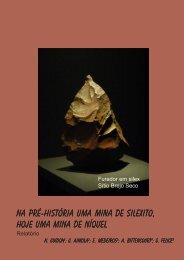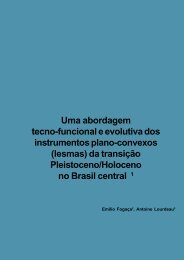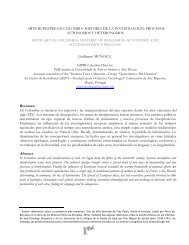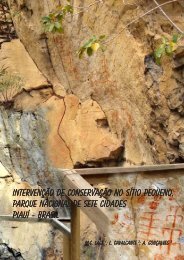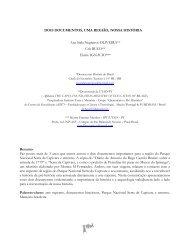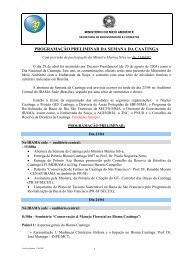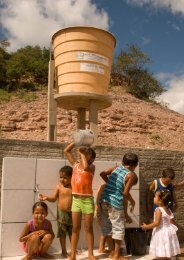Untitled - Fundação Museu do Homem Americano
Untitled - Fundação Museu do Homem Americano
Untitled - Fundação Museu do Homem Americano
You also want an ePaper? Increase the reach of your titles
YUMPU automatically turns print PDFs into web optimized ePapers that Google loves.
Global Rock Art Congress<br />
29 Junho – 3 de Julho 2009<br />
Simbologia de Genero: Algunas Lecturas Sobre Iconografia Fenenina y Masculina en el Arte<br />
Ruprestre de las Sierras de San Francisco y Guadalupe, Baja California Sur, Mexico<br />
Maria de la Luz Gutiérrez Martinez, México<br />
En las cordilleras centrales de la península de Baja California se manifiesta uno de los repertorios de arte<br />
rupestre más extraordinarios de México. Aquí, en cientos de sitios localiza<strong>do</strong>s en los cañones y mesas<br />
de estas montañas, fueron plasmadas numerosas pinturas rupestres y petroglifos, portentosa obra de<br />
los antiguos habitantes de esta región. Hasta el momento las sierras más investigadas son las de San<br />
Francisco y Guadalupe, en las cuales se han registra<strong>do</strong> cerca de 1,150 sitios con arte rupestre. Una<br />
característica que llama mucho la atención porque imprime marcadas diferencias en el arte rupestre de<br />
estas <strong>do</strong>s sierras es el tratamiento que en la Sierra de Guadalupe se le dio a la figura humana, aquí se<br />
percibe un cuida<strong>do</strong>so diseño de los atributos sexuales en los antropomorfos de ambos géneros y otros<br />
indicios visuales que aparecen con cierta frecuencia relaciona<strong>do</strong>s a unos y otras. En la ponencia se<br />
presentará una lectura preliminar de algunas imágenes y composiciones que pudieran estar relacionadas<br />
a una iconografía de género en el arte rupestre de estas montañas.<br />
The Feminine In Mexico’s Baja California Sur Rock Art<br />
Elaine Moore, Esta<strong>do</strong>s Uni<strong>do</strong>s da América<br />
Female imagery in art making through the ages usually employs visual metaphor to describe the female<br />
anatomy, hair <strong>do</strong>’s and dressings, body embellishment, wearing apparel and artistic composition. Some of<br />
these metaphorical images transcend time, presenting themselves either deliberately or subconsciously in<br />
art. To that end this paper will discuss the imagery in Baja California Sur’s Sierra de San Francisco rock<br />
art in the context of ageless female metaphor by contrasting it to contemporary and historical symbolism<br />
exemplified by artist’s such as Artemisia Gentileschi, Judy Chicago and Georgia O’Keefe.<br />
L’art Rupestre Et Le Matriarcat: Une Reflexion Historique-Critique Sur Les Representation<br />
Academiques de La Deesee´-Mere Et Le Pouvoir Des Femmes dans la Pré-Histoire<br />
Luciana de Campos, Brasil<br />
73<br />
La théorie du matriarcat - le supposé pouvoir des femmes dans certaines cultures et des périodes de<br />
l´humanité, a commencé au cours de le XIX siècle avec les publications de J. Bachofen, avec une<br />
grande influence dans l´Antropologie, l´Archeologie, la Théorie du mythe, la Psychologie, entre autres<br />
disciplines. La théorie du matriarcat a été développé plus tard dans les études d´art rupestre de l´Europe<br />
à l´Amerique du Sud, en particulier dans les deux types de matériaux de trace: les meubles avec des<br />
sculptures des représentations des femmes et fixes, avec des pétroglyphes et des peintures pariétales<br />
disant représentant la vulve. Notre principale intention est de faire une refléxion critique sur les idées<br />
femelles présents dans les recherches archéologiques dans le XXI siècle et, avec les principales<br />
références théoriques des oevres de Stella Georgoudi et Lucina Muñoz et de la métho<strong>do</strong>logie du genre,<br />
en particulier ceux qui résultent de Judith Butler et Joan Scott.<br />
Sex and Gender in the rcok Art of Valcamonica<br />
Mila Simões de Abreu & Angelo Fossati, Portugal/Reino Uni<strong>do</strong>, Itália<br />
At first sight, the rock Art of Valcamonica (Lombardy, Italy) is obviously <strong>do</strong>minated by the male figure,<br />
especially the warrior. Unambiguous female figures are very few and almost all belong to the Bronze<br />
Age or Early Iron Age. Sexual scenes exist and are among the most interesting from the point o view of<br />
complexity and interpretation. In this presentation, we will address the question of how gender is present<br />
in the Camunian engravings and what place sex and this iconography had in the valley. Are there male<br />
and female sites, as in other parts of the world? This are among the questions we will try to answer in<br />
this paper.<br />
Parque Nacional Serra da Capivara<br />
Piauí, Brasil




